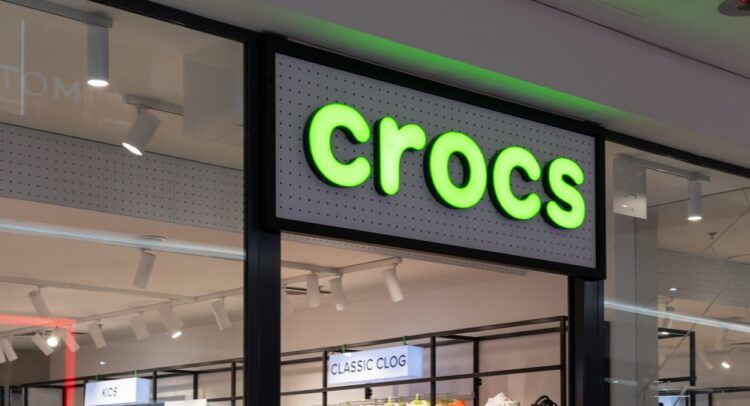Crocs Inc. (CROX) may have a reputation for making unsightly footwear, but there’s definitely nothing unsightly about the stock’s compelling fundamentals. The comfy shoe company has been an excellent value stock, with impressive outperformance compared to the broader market over the past five years. Crocs’ shares have surged ~480%, far outpacing the ~142% gain of the S&P 500 (SPY). This growth has been driven by a mix of rapid top and bottom-line expansion, so I’m leaning bullish on this Colorado-based consumer favorite.
Confident Investing Starts Here:
- Easily unpack a company's performance with TipRanks' new KPI Data for smart investment decisions
- Receive undervalued, market resilient stocks right to your inbox with TipRanks' Smart Value Newsletter
Despite the company’s cult-classic brand awareness and widespread adoption, over the past 12 months, Crocs’ stock has taken a hit due to the underperformance of the HEYDUDE brand, which has struggled to gain traction. Although Crocs’ unit sales saw significant increases in the latest quarter, the stock has lost nearly 26% of its value over the past year. Even so, the bullish long-term investment thesis on Crocs still stands, mainly due to its robust capital returns and appealing valuation.
In fact, Crocs aligns perfectly with hedge fund manager Joel Greenblatt’s ‘Magic Formula’ strategy, outlined in his book ‘The Little Book That Still Beats the Market‘, first published in 2005. The Magic Formula recommends buying stocks that combine high return on capital and high earnings yield, as these tend to outperform the broader market over time. Essentially, the formula blends two key investment principles: purchasing companies with strong earnings potential (value investing) and investing in those that make efficient use of capital (quality investing).
For these specific reasons, which combine value and quality, I maintain a Buy stance on Crocs, believing the company will continue to deliver returns above the broader market for those who hold it long-term.
Why Crocs’ Return on Capital Remains Impressive
As a company with strong business fundamentals, Crocs has consistently maintained robust returns on its capital in recent years. But first, let’s quickly go over how Return on Capital (ROC) is calculated. Simply put, it’s the ratio of operating income (EBIT) to capital employed, where capital employed is defined as total assets minus current liabilities.
Over the last five years, Crocs has averaged a return on capital of 32.5%. In 2024, the company reported a ROC of 25.7%, slightly down from 26.5% in 2023 but still up from 23% in 2022. These figures are much lower compared to 2021, when ROC peaked at nearly 60%. The unusually high comparable ROC in 2021 was partly because the company’s capital employed didn’t yet reflect the HEYDUDE acquisition, which involved a $2.5 billion cash and stock deal.
Starting in 2022, this amount was added to the balance sheet as other intangibles and goodwill, such as HEYDUDE’s trademarks and intellectual property. At the same time, Crocs’ operating income nearly doubled, increasing from $683 million in 2021 to $1 billion in 2024.

This shows that while Crocs’ return on capital has dropped significantly since 2021, it’s not necessarily due to decreased operational efficiency. Instead, it reflects the addition of long-term assets and intangibles following the HEYDUDE acquisition.
For context, a good return on capital typically exceeds a company’s cost of equity. In Crocs’ case, with a beta of 1.2 and an equity risk premium of 4.1%, its cost of equity comes out to around 9.2%. So, Crocs’ return on capital, currently at 25.7%, is very attractive, comfortably above its cost of equity.
Crocs’ Earnings Yield Shows Its Undervalued Potential
Crocs’s other critical indicator is its earnings yield, which highlights the company’s attractive valuation. According to Greenblatt’s formula, this metric is calculated by dividing EBIT by enterprise value. Crocs currently has an enterprise value of $7.47 billion, which includes its market capitalization and net debt. In the most recent fiscal year, Crocs reported operating income (EBIT) of $1 billion, resulting in an earnings yield of 14%.

As a benchmark, companies with an earnings yield higher than the risk-free rate—typically represented by the 10-year U.S. Treasury bond yield—are considered undervalued. In simpler terms, Crocs is generating significantly more earnings (relative to its market value) than investors could earn from a low-risk, long-term government bond.
Is Crocs Inc. a Good Stock to Buy?
Wall Street analysts are leaning bullish on CROX stock. Out of the 12 analysts covering the stock over the last three months, nine have rated CROX as a Buy, and three have rated it as a Hold. Notably, not a single analyst rates CROX as a Sell. The average price target for CROX stock is $131 per share, which suggests an upside potential of around 21% from the current share price.

Undervalued Status Puts Crocs Into Focus
Crocs is a solid pick as a value stock, with all the qualities needed to outperform the broader market over the long term. While the company’s return on capital has dropped due to the HEYDUDE acquisition at the end of 2021, its operational efficiency remains strong. Moreover, its valuation suggests that CROX is likely undervalued. With that in mind, I still consider Crocs a compelling stock to hold for the long haul, as it continues to combine high returns on capital with an attractive share price, which should ultimately lead to alpha generation.
Looking for a trading platform? Check out TipRanks' Best Online Brokers guide, and find the ideal broker for your trades.
Report an Issue










